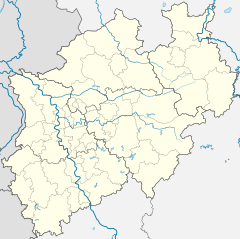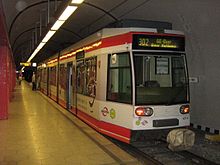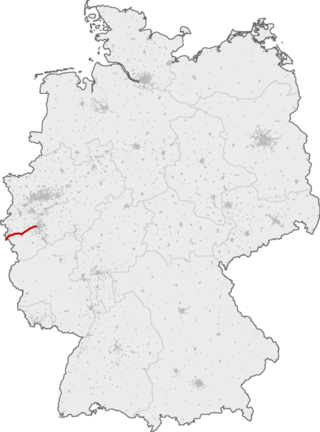
The Cologne–Aachen high-speed line is the German part of the Trans-European transport networks project high-speed line Paris–Brussels–Cologne. It is not a newly built railway line, but a project to upgrade the existing railway line which was opened in 1841 by the Rhenish Railway Company. When it was continued into Belgium in 1843, it became the world's first international railway line.

Köln Hauptbahnhof is the central railway station of Cologne, Germany. The station is an important local, national and international transport hub, with many ICE, Eurostar and Intercity trains calling there, as well as regional Regional-Express, RegionalBahn and local S-Bahn trains. EuroNight and Nightjet night services also call at the station. It has frequent connections to Frankfurt by way of the Cologne–Frankfurt high-speed rail line, which starts in southern Cologne. On an average day, about 280,000 travellers frequent the station, making it the fifth busiest station in Germany.
Duisburg Hauptbahnhof is a railway station in the city of Duisburg in western Germany. It is situated at the meeting point of many important national and international railway lines in the Northwestern Ruhr valley.

Bielefeld Hauptbahnhof is the main station in the region of Ostwestfalen-Lippe, in the German state of North Rhine-Westphalia. It is an important station because of the size of the city of Bielefeld and its location at the Bielefeld Pass, which makes it a node for long-distance and regional traffic. It was opened in 1847 with the opening of the Cologne-Minden trunk line. It is classified by Deutsche Bahn as a category 2 station.

Bonn Hauptbahnhof is a railway station located on the left bank of the Rhine along the Cologne–Mainz line. It is the principal station serving the city of Bonn. In addition to extensive rail service from Deutsche Bahn it acts as a hub for local bus, tram, and Stadtbahn services.

Witten Hauptbahnhof is a railway station in the town of Witten in western Germany. It is situated southwest of the town.

Gelsenkirchen Hauptbahnhof is a railway station in the German city of Gelsenkirchen. It connects the city to the regional and long-distance rail service of Deutsche Bahn and other railway companies in Germany.
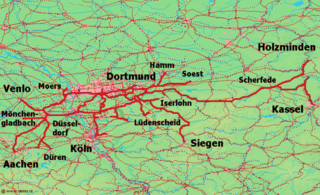
The Witten/Dortmund, Oberhausen/Duisburg railway is one of the most important railways in Germany. It is the main axis of long distance and regional rail transport on the east–west axis of the Ruhr and is served by Intercity-Express, InterCity, Regional-Express, Regionalbahn and S-Bahn trains.

Wanne-Eickel Hauptbahnhof is a railway station in the former city of Wanne-Eickel, now part of Herne in western Germany.

Köln Hansaring railway station is situated in the city of Cologne in the German state of North Rhine-Westphalia, about one kilometre (0.62 mi) northwest of Köln Hauptbahnhof.
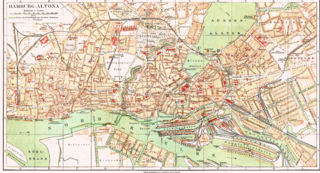
The Hamburg-Altona link line is a railway line in Hamburg, Germany. Nowadays, it connects the lines from the north and northwest of Hamburg and Altona station with Hamburg Hauptbahnhof and the lines to the southwest, south and east. Initially designed as a freight line only, it is now one of the busiest lines in Germany. It includes the suburban tracks of the Hamburg Stadtbahn, originally the core of the Hamburg S-Bahn.
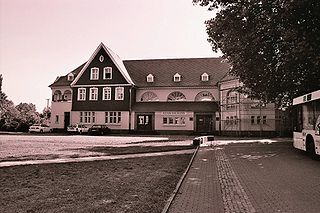
Bochum-Dahlhausen station is located in the Dahlhausen district of Bochum in the German state of North Rhine-Westphalia. The station building dates from the time of the First World War.

Bochum-Langendreer station is now a stop on the Rhine-Ruhr S-Bahn in the district of Langendreer in eastern Bochum in the German state of North Rhine-Westphalia. Langendreer formerly had a 40 hectare marshalling yard, which is now used as a depot, with the location code of EBLA. Until the 1980s, the yard was also the location of a passenger station, which was served by express trains.

Bochum-Langendreer West station is a stop on the Rhine-Ruhr S-Bahn in the district of Langendreer in eastern Bochum in the German state of North Rhine-Westphalia.

Witten-Annen Nord station is located in the Annen district of Witten in the German state of North Rhine-Westphalia. The station is currently classified as a category 6 station. It is served by Rhine-Ruhr S-Bahn line S 5.
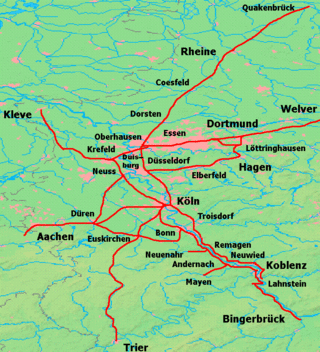
The Osterath–Dortmund-Süd railway is a historically significant line in the German state of North Rhine-Westphalia. Parts of it are closed, much of it is now used for freight only, but several sections are still used for Regional-Express, Regionalbahn or Rhine-Ruhr S-Bahn services.
The Bochum–Essen/Oberhausen railway was built by the Bergisch-Märkische Railway Company to the north of its main line through the central Ruhr to tap traffic from mines and factories in the northern Ruhr region, which is now in the German state of North Rhine-Westphalia.
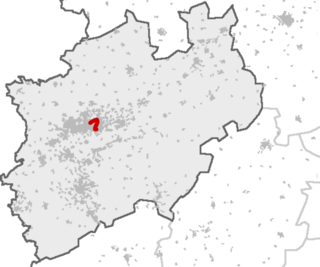
The Bochum–Gelsenkirchen railway, also known as the Glückauf-Bahn, is a passenger railway from Bochum Central Station (Hauptbahnhof) to Gelsenkirchen Central Station in the German state of North Rhine-Westphalia. It is served by Regionalbahn passenger service RB 46). It is also used by freight traffic from Bochum freight yard at the former Bochum Süd station and Bochum-Präsident to Gelsenkirchen-Schalke Nord. The line was built in sections between 1867 and 1876 of the Bergisch-Märkische Railway Company. The curve connecting to Bochum Central Station was opened in 1979.

Bochum Nord station was a station on the Ostring in the city of Bochum in the German state of North Rhine-Westphalia. It was built by the Rhenish Railway Company between 1871 and 1874 and opened on 15 October 1874. The station, which was originally called Bochum Rheinisch ("Rhenish") station, for a long time served passenger and freight traffic on the Osterath–Dortmund Süd railway.

The Dortmund freight bypass railway is a railway line in the north of the city of Dortmund in the German state of North Rhine-Westphalia. It is designed for the carriage of freight only, allowing freight trains that pass through Dortmund to avoid Dortmund Hauptbahnhof, reducing delays to passenger traffic and reducing threat of dangerous accidents in the city centre.


